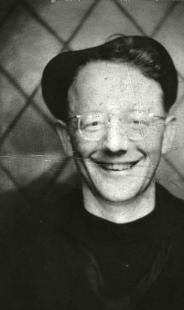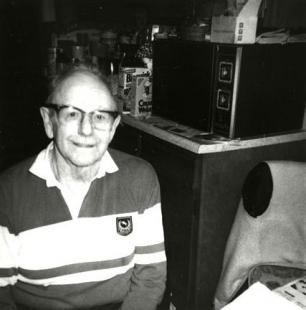Mike Skerbine
Era: World War II
Military Branch: Coast Guard


Mike Skerbine enlisted with the Merchant Marines in 1943. Home at entry: Kelly Lake, Minnesota.
He served as a Steward's mate, ordinary Seaman, fireman, and water tender aboard the SS Patrick C. Boyle, William Hodson, Mooks Fields, and Gulfpride in the Atlantic, Pacific, and Mediterranean zones.
Shortly after graduating from high school, Mr. Skerbine and his friend, Louis Vidmar, hitchhiked to Duluth, Minnesota, in 1935 and attempted to join the U.S. Navy, but they were not recruiting.
In 1942, Mr. Skerbine attempted to join the Army but was turned down because of poor eyesight. Undaunted, he went back to Duluth and joined the U.S. Maritime Service (Merchant Marine), Coast Guard in 1943.
He trained in Sheepshead Bay, Brooklyn, New York, for several weeks and was then sent to Baltimore, Maryland. His first assignment was as Steward’s Mate. His ship was part of a massive convoy: tankers, Liberty ships, destroyers, cruisers, battleships, and aircraft. Over the course of the war, Mr. Skerbine served on several vessels and in many capacities—as Seaman, Fireman, and Water Tender—aboard the SS Patrick C. Boyle, William Hodson, Mooks Fields, and Gulfpride in the Atlantic, Pacific, and Mediterranean Theaters.
Source: Veteran’s account (see below)
Mike Skerbine of Kelly Lake, entered the U.S. Maritime Service (Merchant Marine), Coast Guard in 1943. He served as a steward’s mate, ordinary seaman, firearm, and water tender aboard the SS Patrick C. Boyle, William Hodson, Mooks Fields, and Gulfpride in the Atlantic, Pacific, and Mediterranean Zones.
“Shortly after my high school graduation in 1935, I hitchhiked to Duluth to sign up for the Navy. My good friend Louis Vidmar from Chisholm was with me. They did not need any men, so we bummed home again.
"In 1942, I enlisted in the Army and went to Fort Snelling for examination. I was turned down because of my eyesight. In 1943, I again went to Duluth and enlisted in the Merchant Marine. Our group went to Sheepshead Bay for training. After six or seven weeks, we were shipped to Baltimore. I was shipped out as a steward’s mate.
"A few weeks later, we were joined by the biggest convoy ever shipped out. There were all kinds of ships: tankers, Liberty ships, destroyers, cruisers, and battleships. What a beautiful sight! Aircraft were all over the place.
“We were out on the Atlantic and, as we sailed out, we were told we were going to Oran, North Africa. As we neared the port, we could hear the depth charges going all night and day. We finally landed in Oran and were given shore leave. In all places, we searched for bed sheets—the Arabs would pay good money for them. Every place I went to, all doors and windows were barred.
“We left Oran to go to Italy. I remember going by the Isle of Capri and the other islands close to Italy. There were still big battles going on there. We landed in Naples. Naples and vicinity were bombed several times while I was there. From there, we sailed back to the U.S. It sure was a happy sight to see the Statue of Liberty and drink milk.
“On the next trip, on a Liberty ship, we were at Le Havre, France, and could take a short leave, we found ourselves on a battlefield. From where we stood, we could see bodies rotting in the sun, and you could see land mines in the field. We then went to England and visited Liverpool and Manchester. We found ourselves in a bomb shelter. It was there we heard our president was dead. Back to the U.S.
“Our next trip was to the Persian Gulf, through the Mediterranean Sea to the Suez Canal. At Kramshaw it was over 150 degrees. I got to be friends with a U.S. Sergeant, and he showed me miles and miles of supplies that the U.S. had shipped in. From there, we went back to the Red Sea. We sailed past Madagascar Island to Capetown, South Africa, where we unloaded, then went to the Gold Coast, where we loaded and sailed back to Newport News, Va. The next trip I went on was to Venezuela.
"My last trip was on a tanker, brand new. We went through the Panama Canal, and took a long trip to Australia, landed at Brisbane for a few days and then to Sydney. Many weeks later, we landed back in the U.S.
“On VJ day, I was in Times Square when the war ended . . . I was too shy to do anything. I watched the big parade and was very proud of the United States.”
Mr. Skerbine received the following: Atlantic War Zone Medal, Pacific War Zone Medal, Mediterranean-Middle East War Zone Medal Merchant Marine emblem.
He was discharged in August 1945.
Source: Hometown Heroes: The Saint Louis County World War II Project, 296.

